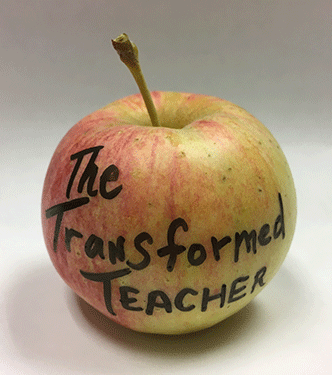THE TRANSFORMED TEACHER – How to Make a Mountain into a Molehill

Uh oh. I’ve got revision paralysis!
I can’t possibly change my class – that mountain is too big to climb. It’s too massive. It’s not worth all the effort. I don’t have the time. Right?
You might be wondering how you could ever transform an impassable mountain into a manageable molehill. It might be easier than you think. Let’s start at a familiar place – home sweet home.
How Do You Tackle Mount Messy Home?
When I think about revamping my class, I think about cleaning my home, which is one of those chores that fills me with energy or despair, depending on the circumstance. Let’s do some self-assessment. Which of these sounds most like you?

- Mess, what mess? My home is spotless. I clean up spills immediately. I could eat off these floors. Please leave your shoes by the door. And don’t sit on the sofa – that’s just for decoration. I have a schedule and I stick to it. Every. Single. Day. No. Matter. What!
- I enjoy organized chaos. Unsightly untidiness is confined to discrete areas, like the hall closet and under the bed. Sure, whenever I look at those areas I cringe, but then I walk away. Out of sight, out of mind.
- I set aside time to clean one spot. But then everything else seems messy. Before I know it, I’ve spent all day cleaning my entire house and am completely exhausted. Or I get interrupted, and my place is a tornado zone for weeks.
- Cleaning is overrated. Everyone knows a little dirt is good for you. Can’t people and crumbs coexist peacefully? My time is too precious to waste on waste.
- Floor, what floor? My home is so dirty I… haven’t seen the floor for years… can create an entire meal from sofa scavenging… hired someone else to clean… moved. Ciao!
Now think about how you keep your class in shape. Do any of the above sound like you? Knowing how you operate is half the battle when it comes to overcoming those overwhelming mountains.
Mountain or Molehill?
As academics, we rarely have the luxury of time. Clocks are omnipresent jesters mocking our best efforts to cross items off our scrolling to-do lists. Rebuilding your class from scratch is likely not an option. The key words here are PRIORITIZE and MANAGEABLE. You don’t have to ditch everything you struggled to create. You don’t have to fix everything all at once. One step at a time.
focus on tasks that are a 10-25% change from the norm
In fact, according to Stephan Gardner’s assessment of the book Principles of Self-Management, it’s best to focus on tasks that are a 10-25% change from the norm. If the change is too drastic, it becomes overwhelming, and we might backslide or fall off the cliff into the abyss of self-sabotage. If the change is too minor, we might not see the value in climbing. We might just stay at basecamp.
Examine your mountain. Can you identify some discrete molehills?
Is Your Mountain Built on a Swamp?
One of the easiest, and most powerful ways to improve your class, is to examine the underlying framework. Could it use some tweaking or an upgrade? Consider using backward design to move your class ahead. There are lots of resources on this topic, including Wiggins and McTighe (1998), who lay things out in an accessible way.
- Your first task is to identify desired results, or “determine what students should know, understand, and be able to do.”
- The second task is to determine acceptable evidence, or “how we will know if students have achieved the desired results.”
- The third task is to plan learning experiences and instruction, or “decide what activities students will do and what resources and materials are needed.”
It’s likely you already have many necessary elements in place, but shifting the focus to identifying desired results can help you align your activities and assessments with your goals and learning outcomes.

Your class will become more cohesive and unified, rather than a jumbled mess of disconnected ‘I think I’m doing this for a good reason, but I’m not sure exactly what it is’ moments. You’ll avoid the pitfalls of classwork that serves no purpose. Spend a little bit of time on identifying desired results and that mountain might crumble into some very distinct (and doable) molehills.
Feeling stuck? Ideas seem dumb or dull? Bounce them off trusted colleagues or students. A little perspective can go a long way. Any don’t forget, the NDSU Office of Teaching and Learning is a “supportive place to find workshops, resources, and assistance to better your teaching.”
Chin up!
The Transformed Teacher

The Transformed Teacher is a faculty member who took a bold step out from behind highly detailed lecture notes and a gigantic podium into the teaching-verse, which is a magical place filled with helpful tips, tools, and teachers.
As I learn more about teaching, I find I’m significantly better than I was before, and a lot less neurotic. In fact, sometimes teaching is downright fun. Imagine that.
REFERENCES:
Gardner, Stephan. 2018. 10 ways you can supercharge your dopamine levels without medication. Collective Evolution website, January 19, 2018. http://www.collective-evolution.com/2018/01/19/10-ways-you-can-supercharge-your-dopamine-levels-without-medication/ Accessed 4-11-18.
Marshall JC, McHardy B. Principles of Self-Management: the Key of Personal and Professional Success. https://www.selfmgmt.com/book/principles-of-self-management
Wiggins G, McTighe J. 1998. Chapter 1. What is Backward Design? In: Understanding by Design. Association for Supervision and Curriculum Development, Alexandria, VA. https://educationaltechnology.net/wp-content/uploads/2016/01/backward-design.pdf
Check out my previous posts:
Self-growth in academia: support sandwich evolution
Group work (pt. 2): What’s in a name?
Top 10 list for day 1
3 nuggets of wisdom for dealing with end-of-semester ‘feedback.’
5 steps to changing behavior.
Stuck in the middle (of the semester) with me.
Group work (pt. 1): Let’s get real.
Justifying just makes life easier.
Say something. Anything. Please…?
Changing educational pain to pleasure.